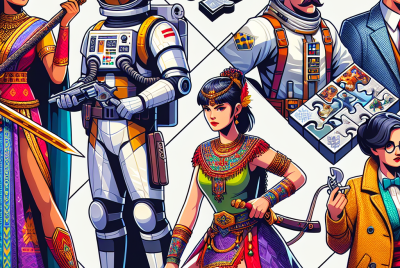Gameplay Mechanics Through the Ages: How They’ve Evolved
The Evolution of Gameplay Mechanics: A Deep Dive
1. Early Video Games: Simple Mechanics
The history of video games can be traced back to the early 1970s, where gameplay mechanics were simplistic yet groundbreaking. Titles like “Pong,” developed by Atari, introduced fundamental mechanics like paddle control and basic scoring systems. Players engaged in what was essentially a digital version of table tennis, underscoring mechanics reliant on fast reflexes and accuracy. The graphical fidelity was minimal, but the gameplay loop—playing against either a machine or another player—was immediately engaging. The simplicity of one-button mechanics allowed games to reach wider audiences, setting the stage for future innovations.
2. The Rise of 2D Platforms
In the mid-1980s and early 1990s, gaming saw the emergence of 2D platformers epitomized by Nintendo’s “Super Mario Bros.” This period introduced the concept of level progression, character abilities, and power-ups. Gameplay mechanics evolved with the introduction of features like jumping, running, and item collection, encouraging exploration and interaction in richly designed worlds. Elements like the introduction of checkpoints and lives created a sense of progression and stakes, enhancing player engagement. The combination of simple yet diverse mechanics contributed to the genre’s massive appeal and laid the groundwork for complex narrative structures.
3. The 3D Revolution
The 3D revolution in gaming during the mid-1990s triggered a significant paradigm shift. Titles such as “Doom” and “Super Mario 64” not only incorporated 3D graphics but also innovated gameplay mechanics such as first-person and third-person perspectives. The mechanics of navigation transformed as players could now control characters in a three-dimensional space. Collision detection and spatial awareness became vital components, changing how players interacted with environments. The introduction of camera controls and complex level designs led to an array of gameplay mechanics that rewarded exploration, including secret areas and hidden collectibles.
4. Open World and Non-Linear Play
By the early 2000s, open-world games like “Grand Theft Auto III” pushed the boundaries of gameplay mechanics. These games featured non-linear storytelling, allowing players to immerse themselves in vast, explorable worlds. The mechanics now included not only main storyline quests but also side quests, dynamic NPC interactions, and environmental destruction. Players were free to choose their paths, leading to a more personalized gaming experience. This evolution added layers of complexity, with developers integrating systems for character development and choices impacting narrative outcomes.
5. Online Multiplayer and Cooperative Gameplay
As internet access became widespread, the rise of online multiplayer games transformed gameplay mechanics. Titles like “World of Warcraft” incorporated RPG elements with cooperative and competitive gameplay. The integration of guilds, raids, and PvP combat mechanics created communities and social interactions within gaming frameworks. Game mechanics evolved to include resource gathering, crafting systems, and intricate progression systems that encouraged long-term player investment. The collaborative strategy in multiplayer mechanics became essential to the genre, fostering teamwork and communication among players.
6. Battle Royales and Evolving Competition
The late 2010s saw the explosion of battle royale games such as “Fortnite” and “PUBG.” These games feature a unique take on gameplay mechanics, condensing traditional gameplay loops into fast-paced, high-stakes situations. Core mechanics included shrinking play zones, scavenging for weapons, and survival strategies, culminating in an all-or-nothing victory for the last player or team standing. The addition of building mechanics in “Fortnite,” for instance, introduced a new level of skill expression and creativity. Seasonal updates and events also revolutionized how developers interacted with their communities, constantly evolving the gameplay experience.
7. Mobile Gaming and Touch Mechanics
The mobile gaming boom introduced touch-based gameplay mechanics that transformed how games are designed and played. Titles like “Angry Birds” and “Candy Crush” optimized mechanics for short bursts of gameplay, appealing to casual gamers. Intuitive touch controls allowed for innovative mechanics like swiping, tapping, and pinching, creating accessible gaming experiences. Mobile games leveraged microtransactions and social sharing to enhance engagement, which in turn influenced how traditional games approached monetization and player retention.
8. The Rise of Indie Games and Experimentation
The indie game movement, gaining traction in the 2010s, spotlighted innovative gameplay mechanics by exploring unconventional narratives and styles. Games like “Celeste,” “Hollow Knight,” and “Undertale” pushed boundaries, incorporating unique mechanics like permadeath, slope climbing, and emotional storytelling. The success of these games demonstrated that gameplay mechanics could be both simple and deeply resonant, allowing players to connect on a personal level while enjoying novel interactions. Indie developers often leaned into experimentation, giving rise to hybrid mechanics that mixed genres, enriching the gaming landscape.
9. Accessibility and Inclusive Design
As awareness of game accessibility grew, so did the evolution of gameplay mechanics tailored for a wider audience. Adaptive controls, customizable settings, and features like text-to-speech have begun surfacing in major titles. Games like “The Last of Us Part II” introduced mechanics that consider players with disabilities, ensuring that everyone can enjoy the same rich experiences. This revolution in design mechanics reflects a more inclusive approach to gaming, acknowledging diverse player needs and extending the enjoyment of games to a broader demographic.
10. Future Trends in Gameplay Mechanics
Looking ahead, gameplay mechanics continue to evolve with technology. Virtual reality (VR) and augmented reality (AR) are shaping new forms of interaction, with immersive environments that prioritize physical movement and realism. Games are increasingly integrating AI, allowing for more adaptive, personalized gameplay experiences based on player behavior. The combination of these emerging technologies suggests a future where the boundaries of gameplay mechanics will be increasingly blurred, promising rich, unprecedented experiences for gamers.
11. Conclusion
The evolution of gameplay mechanics is a testament to the industry’s ingenuity and adaptability. Each era has introduced fresh ideas and concepts that build upon the past, leading to more intricate and engaging player experiences. From rudimentary mechanics of early games to the dynamic, multifaceted systems of today, gameplay has continually shifted to meet the needs and preferences of players constantly exploring new horizons. As technology progresses, so too will the evolution of gameplay mechanics, ushering in an exciting era for the future of gaming.




